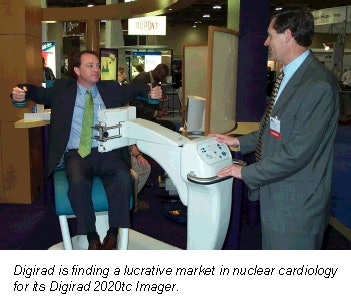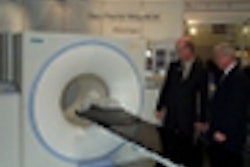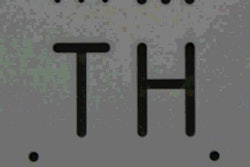
TORONTO - Solid-state digital gamma camera developer Digirad is using this week’s Society of Nuclear Medicine meeting to highlight the utility of its product for portable applications. The San Diego company hopes to replicate in general SPECT the success it is experiencing in nuclear cardiology, where it is selling the vast majority of its cameras.
Digirad was the first company to commercially launch a digital gamma camera based on solid-state detectors rather than photomultiplier tubes (PMTs) and scintillation crystals. That product, Digirad 2020tc Imager, is still the only solid-state digital gamma camera on the market.
It wasn’t an easy road, though. Digirad received U.S. Food and Drug Administration approval for the first version of 2020tc Imager in 1997. But that product’s detector material was based on cadmium zinc telluride, which is extremely expensive to produce. Digirad found that it wasn’t able to manufacture a CZT camera at a price point that the market could afford, according to Scott Huennekens, president and CEO of the firm.
Digirad switched gears, adopting cesium iodide as a detector material. That version of 2020tc Imager was commercially launched in July 2000, and has the same performance as the CZT model but at a lower cost, he said. The switch to cesium iodide cost Digirad two years of time that it could have been on the market selling a product, but the switch was worth it, given its recent success, Huennekens said. The camera now sells for around $300,000.
 |
Digirad 2020tc Imager resembles an ultrasound cart with an articulated arm, which houses the system’s 8.5 x 8.5-in. detector head. The head consists of 4,096 individual 3 x 3-mm detector elements. As a result of the small detector head, 2020tc Imager is remarkably light and compact. It can be sited in a space as small as 5 x 9 sq. ft., weighs about 425 lb., and can easily be moved to other locations, according to Richard Conwell, vice president of marketing.
Patients are imaged while sitting in a chair; for cardiac SPECT studies, the chair rotates while the detector remains stationary. Digirad believes that this imaging configuration, which it calls SPECTpak, eliminates artifacts caused by the hemidiaphragm and enables the detector head to be positioned closer to the heart.
The system has rapidly found a niche in nuclear cardiology. Digirad has sold 120 cameras in the past year, with 115 of those units purchased for cardiology applications, Conwell said.
The unit’s success in heart imaging has prompted Digirad to make a foray into the imaging services realm, launching Digirad Imaging Solutions to provide mobile services to small cardiology practices that don’t have the volume to buy their own camera. Digirad sees cardiac imaging services as a market whose potential dwarfs that of PET, currently nuclear medicine’s golden child. DIS has 20 vans operating in Florida, Pennsylvania, and New Jersey, and DIS recently received licenses to operate in California and Ohio as well.
At this week’s SNM show, Digirad is highlighting the FDA clearance this month of its Cedars-Sinai QGS/QPS (quantitative gated SPECT/quantitative perfusion SPECT) package. The software is the most popular quantitative cardiac SPECT package, and enhances 2020tc Imager’s versatility, Conwell said. The company is also highlighting a new armrest for SPECTpak.
Digirad hopes that the conference will help it lay the groundwork for success in the general SPECT market to match the company’s progress in nuclear cardiology. The vendor believes that hospitals have been slower to purchase the system because the product’s July launch didn’t give many the time to put funds for the product in their 2001 capital acquisition budgets. Sales of 2020tc Imager to the hospital market should pick up as hospitals include the product in their 2002 budgets. The camera’s portability could be an attractive feature for many hospitals, which might be interested in purchasing the system as a second camera, Conwell said.
By Brian CaseyAuntMinnie.com staff writer
June 27, 2001
Related Reading
Marconi will develop whole-body solid-state gamma camera, June 20, 2001
Digirad buys mobile nuclear cardiology provider NIS, November 10, 2000
Digirad plans cardiology services efforts, November 2, 2000
Digirad begins shipping 2020tc, August 23, 2000
Digirad lands distribution deal in Japan, February 29, 2000
Click here to post your comments about this story. Please include the headline of the article in your message.
Copyright © 2001 AuntMinnie.com




















